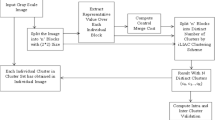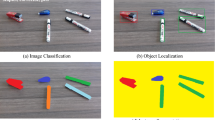Abstract
We propose an alternative hyperspectral image segmentation method based on a geometric active contour model. First, we use a spectral angle as a measure index to measure the spectral similarity between the pixels, and the spectral angle constrained function is constructed based on spectral similarity. Then, depending on the class separability criterion, an optimal band is chosen which is suitable for image segmentation. The model retains advantages of the traditional C–V model in regional information with rich textures and edges. Its unique feature is exploiting the characteristics of hyperspectral remote sensing images in regions with abundant spectral information. As a consequence, the capture capability, segmentation speed, and accuracy are enhanced. Finally, we present experiments using WorldView and Hyperion images, from whose results demonstrate the improved attributes of the proposed method over those of the traditional C–V model. The proposed model provides better results than the traditional models both in segmentation accuracy and computational efficiency.






Similar content being viewed by others
References
Chai TY, Goi BM, Tay YH et al. (2015) Local Chan-Vese segmentation for non-ideal visible wavelength iris images. 2015 Conf Technol Appl Artif Intell (TAAI): 506–511
Chan TF, Vese LA (2001) Active contours without edges. IEEE Trans Image Process 10(2):266–277
Chao JN, Guan ZQ, Li DR (2005) Study on the approaches for segmentation of hyper spectral images based on DMN. J Remote Sens 9(5):596–603
Chen B, Lai JH (2007) Active contour models on image segmentation: asurvey. J Image Graph 12(1):11–20
Fang LL, Wang XH, Sun Y, Xu KN (2016) Remote sensing image segmentation using active contours based on inter correlation of nonsubsampled contourlet coefficients. J Electron Imaging 25(6):061405–061409
Kass M, Witkin A, Terzopoulos D (1988) Snake: active contour models. Int J Comput Vis 1(4):321–331
Kruse FA, Lefkoff AB, Boardman JW (1993) The spectacle image processing system (SIPS) interactive visualization and analysis of imaging spectra meter data. Remote Sens Environ 44:145–163
G. Mercier, S. Derrode, and M. Lennon (2003) Hyperspectral image segmentation with Markov chain model. Proc IEEE Int Geosci Remote Sens Symp Toulouse: 3766–3768
Morel JM, Solimini M (1994) Variation methods in image segmentation. Brikhauser, Boston, MA
Mustafa AF, Bayat O, Osman N (2017) Ucan quality of remote sensing data for extracting water body. Comput Intell Design (ISCID): 1–5
Nian YJ, Zhang Z, Wang LB, Wan JW (2010) Target segmentation for hyperspectral imagery based on FastICA. Acta Photonica Sinica 39(6):1003–1009
Osher S, Fedkiw R (2003) Level set methods and dynamic implicit surfaces. Cambridge University Press, New York
Sapiro G (2003) Geometric partial differential equations and image analysis. Cambridge University Press, New York
Sethian JA (1999) Level set methods and fast marching methods. Springer, New York
Silverman J, Rotman S, Caefer CE (2002) Segmentation of hyper spectral images based on histograms of principal components. Proc SPIE-Imaging Spectromet: 270–277
Tarabalka Y, Benekiktsson JA, Chanussot J (2010) Multiple spectral-spatial classification approach for hyper spectral data. IEEE Trans Geosci Remote Sens 38(1):1410–1413
Wang XH, Fang LL (2013) Survey of image segmentation based on active contour model. Pattern Recogn Artif Intell 26(8):751–760
Wang XH, Jin YB (2013) The active contour model for segmentation of coastal hyper spectral remote sensing image. J Image Graph 18(8):2–3
Yu XC, An WJ, Lv ZH, Zou W (2012) Automatic weighting fusion classification method based on spectral angle and spectral distance. J Geol 36(1):33–36
Zhang WJ, Zhang JP, Zhang Y (2008) Hyperspectral image segmentation method based on region active contour. Remote Sens Technol Appl 23(3):351–355
Funding
This research has been funded by the National Natural Science Foundation of China (Grant Nos. 41671439 and 61402214), and Innovation Team Support Program of Liaoning Higher Education Department (LT2017013).
Author information
Authors and Affiliations
Corresponding author
Additional information
Publisher’s Note
Springer Nature remains neutral with regard to jurisdictional claims in published maps and institutional affiliations.
Rights and permissions
About this article
Cite this article
Wang, X., Li, Z., Zhou, X. et al. Segmentation model for hyperspectral remote sensing images based on spectral angle constrained active contour. Multimed Tools Appl 78, 10141–10155 (2019). https://doi.org/10.1007/s11042-018-6608-y
Received:
Revised:
Accepted:
Published:
Issue Date:
DOI: https://doi.org/10.1007/s11042-018-6608-y




